Abstract
In this study, the required capabilities and key element technologies of smart underground ammunition storage were analyzed using the Delphi technique. Twenty-four external experts on industry 4.0 smart technology were selected. A total of 18 required capabilities and 32 key element technologies were derived for the construction of smart underground ammunition storage. Smart ammunition storage can be built through the convergence of a range of ICT technologies such as sensors, clouds, big data, precision control, and mobile technologies, along with existing ammunition storages. The combination of these technologies will support human decision making through the use of numerous sensors applied to ammunition storage for collecting data and converting them into big data. In addition, the intelligent information technology introduced in a smart ammunition store will allow soldiers to detect changes in the surrounding environment, which will bring about innovation to an ammunition service. As a result, high-level automation and an intelligent infrastructure can be provided, enabling an improvement in ammunition management capabilities, energy saving, and the establishment of a safe operating environment and a flexible management system. This form of future ammunition storage will be an example solution for major issues in army ammunition services, as well as overcoming challenges such as a reduction in military forces.
1. Introduction
1.1. Background
Ammunition magazines are placed in a wide range of protection zones for human safety and for protecting civilian assets from accidental explosions. These protected zones are based on safety distance, and the minimum separation distance is determined to prevent damage from blast pressure, fragmentation and scattering, and heat generated when an explosion occurs [1,2,3]. Underground ammunition storage has the advantage of reducing safe distance by confining the blast pressure and fragments generated in the event of an accidental ammunition explosion using an underground rock mass. The future ammunition storage discussed in this study, which incorporates smart information and communications technology (ICT), is a “smart underground ammunition storage”. Smart and sustainable buildings have been an active field of research in recent years, achieving remarkable growth in the construction industry. According to a Building Services Research and Information Association report, this field will contribute to improvements in the quality of human life through the application of advanced construction incorporating ICT [4]. In the military sector of South Korea, active research has been on-going toward the development of new solutions for innovation in national defense management that can facilitate a preemptive adoption of smart ICT in the defense sector to ensure national safety and overcome the problems of shortages in military forces, owing to a shrinking population, through the use of new technologies. In particular, along with research in a variety of fields on sustainable construction as well as institutional reform in the Republic of Korea′s (ROK) military [5,6], the need for smart and sustainable military facilities is expected to continuously increase. In addition, the construction of new military facilities and a smart military base has become possible through innovation in ICT technology. To this end, the importance of research in leadership and management for the establishment of smart systems has increased with the derivation of smart technologies that can be incorporated in the systems of human resources, education, training, and supply within the army [7,8,9,10,11]. Despite these on-going efforts by the military forces, compared to the rapid pace of change in civil society, the development of a smart and sustainably built military environment is still insufficient in a number of aspects. In particular, the ammunition management system of the ROK Army is centered on labor intensive and safety-oriented ammunition management services, as shown in Figure 1. In addition, there are inherent environmental, industrial, and management constraints on the whole, indicating that there is a pressing need for innovation and improved conditions through the use of smart ICT as part of the recent fourth industrial revolution.
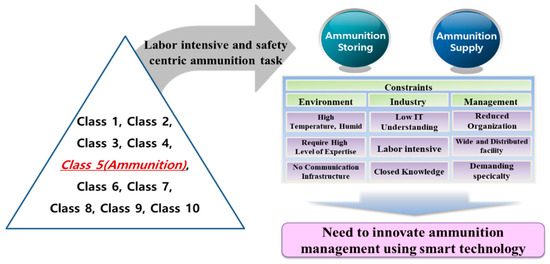
Figure 1.
Restrictions to the ammunition service in the ROK Army.
The ROK Army is planning to build new smart underground ammunition storage systems during the years 2019–2024 to improve management, convenience, and safety assurance as part of the “Smart Mover” project, and with this background it is necessary to examine and identify specific operational capabilities required for the incorporation of smart ICT in line with recent trends.
However, research in ammunition storage is limited to safety improvements from accidental explosion of ammunition, and reduction of the safe distance. There is no research on the improvement of the ammunition storage environment and the efficiency of ammunition operations using smart technology. The improvement of the ammunition storage environment is a very important area to reduce operation time and extend storage life.
Therefore, in this study, as proactive response to the challenges and requirements faced by the ROK Army, we propose an advancement strategy for smart underground ammunition storage for addressing the question: “How should we adopt and operate smart ICT for application to ammunition storage?”
1.2. Objectives and Scope
The primary objective of this study is to determine the required capabilities and key technologies of smart underground ammunition storage. In this regard, to analyze the elements of technology necessary for the implementation of smart ammunition storage in the changing future battlefield environment, development trends in advanced smart ICT at home and abroad were examined. We analyzed cases of technology that are incorporated into platforms such as smart factories for utilization, and collected expert opinions on the technologies required for smart ammunition storage required in a changing battlefield environment. The Delphi technique was employed to derive consensus through several surveys with an advisory group composed of civil-government-military experts. A group of twenty-four experts on military ammunition operation and smart ICT were selected to present the results and establishing the operational capabilities required for smart ammunition storage.
2. Methodology
To analyze the required capabilities for smart ammunition storage operations, the Delphi technique was employed by external experts. The Delphi technique is a decision-making methodology through a consensus among experts. In the absence of accurate information on the problem that needs to be estimated, the Delphi technique is based on the principle of a quantitative objectivity, i.e., that the prediction of a structured group of individuals is more accurate than the prediction of an individual. The Delphi technique has the advantage of removing the following undesirable psychological influences that arise from the process of discussions with relevant parties such as a council or committee: (1) the exclusion of minority opinions and the pressure to conform to the majority, (2) the opinion of a single authoritative person and the influence of this person’s remarks, (3) preliminary coordination before the meeting, and (4) abiding by the conclusion once determined. The Delphi technique combines the merits of a general public opinion poll method and a committee as follows. It repeats the process of collecting opinions, and controlled feedback can be received. In addition, it guarantees anonymity of the respondents, thereby providing an opportunity to present opinion without reservation. Finally, it is a structured communication process that can identify controlled group reactions. For the research procedure, a panel of experts was formed on the problem to be solved, and the survey results were collected through the first survey round using open-ended questions on the research problem, without involving mutual direct interactions. Responses collected through the first round of open-ended questions were compiled by the researcher, and through structured closed-ended questions (second round of the survey), the importance of each item of the question and the degree of agreement (usually on a Likert-type scale) were evaluated.
In the third or further round of surveys, the central tendency and variability (median and interquartile range) were calculated from the responses of the expert panel identified up to the second round of the survey, providing an opportunity for the experts to reconsider and modify their own responses. For opinions that deviate from the majority responses, the reason for the discrepancy is described and the surveys are repeated until the opinions of the expert panel come to an agreement, thus deriving consensus for the given questions.
This is a widely used technique because only a small group of 10–15 experts is needed to obtain useful results. The most important factor to be considered in the Delphi technique is to form a group of experts on the research topic [12,13,14,15]. The eligibility of the expert group participating in the Delphi technique determines the success or failure of the research. Therefore, these expert groups should carefully consider representativeness in the research topic, expertise, sincerity of participation, and the number of participants.
Figure 2 shows the process for deriving consensus and other detailed procedures through a Delphi analysis. As shown in Figure 2, the Delphi technique is a qualitative method that draws consensus among experts and is capable of effectively producing reliable and credible results [16,17]. The panel composed of civil, government, and military experts consisting of 21 members (seven from research institutes, seven from defense companies related to ammunition, and seven actively serving soldiers), all of whom had experience in ammunition-related operations.
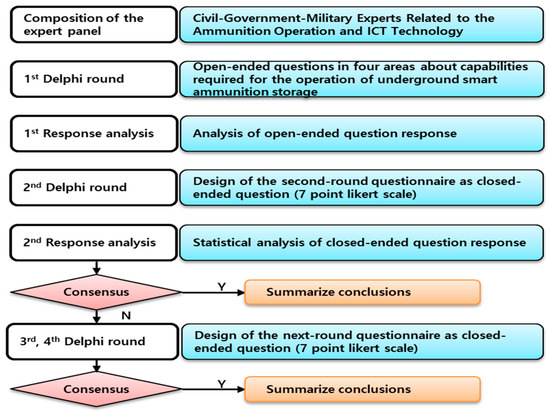
Figure 2.
Delphi technique process.
3. Development Direction for Future Ammunition Service System
The circumstances of national security on the Korean peninsula necessitate the building of a “strong army” for actions against the military threat from North Korea as well as the support of a peace settlement. However, in terms of the demographics of South Korean society, with the recent trend of a low birth rate and an aging population, the current reduction of military forces is expected to continue. Under the current situation in which a looming military threat from North Korea is still present, national defense reform faces the difficulty of responding to all-round security threats including the North Korean threat. One of the solutions proposed to overcome these difficulties is the transformation of the armed forces into science and technology-oriented forces, fully exploiting the science and technology of the fourth industrial revolution. To this end, the ROK Army is promoting smart defense operations and military power, as well as the establishment of a national defense infrastructure through the application of the characteristic elements of intelligence, hyper-connectivity, and convergence.
In the past, the ROK Army promoted an ICT project using radio frequency identification (RFID) to improve the efficiency of the ammunition service system, but the project failed. In an RFID wireless system environment, the metal component of the ammunition surface acts as an obstacle, making it impossible to achieve a 100% recognition rate (only approximately a 77% recognition rate), which impedes the automatic work process of the system. This results in a problem of having to conduct both an RFID project and a manual operation by force. In other words, to attach tags to all ammunition types for all ammunition storage areas, RFID tags were removed from the ammunition storage, and the iron banding of the box unit was detached and then re-banded after the attachment of the tags. In particular, using RFID, the ammunition ICT project caused additional work for the ammunition stockpiles, even when there is little incoming and outgoing ammunition. Figure 3 shows the analysis results of the causes of the failure of the past project in the ammunition RFID system.
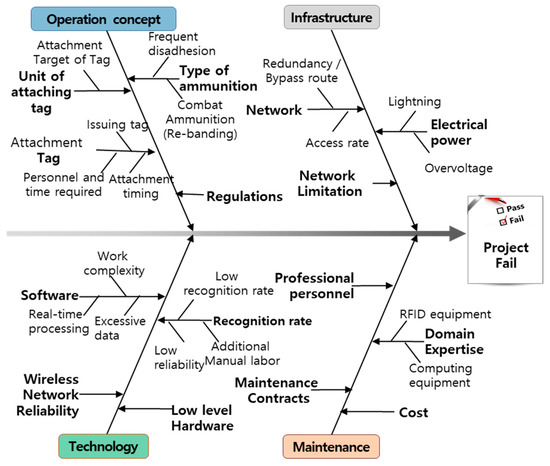
Figure 3.
Reasons for failure of radio frequency identification- (RFID)-based ammunition management project.
Based on these past failures, we aim to develop the future direction of the ammunition business. First, a SWOT analysis (Strengths, Weakness, Opportunities, Threats) was conducted on the current ammunition operations of the ROK Army, the results of which are outlined in Table 1.

Table 1.
Strengths, Weaknesses, Opportunities, Threats (SWOT) analysis results for army ammunition.
As a result of the SWOT analysis, it was possible to identify the type of military unit that most satisfies the requirements for the construction of smart ammunition storage required in the defense sector of the ammunition operation system of the ROK Army. That is, the area of the camp is large compared to the number of forces, and a troop-intensive service is applied. If advanced science and technology can be implemented in these units, a large number of tasks can be efficiently processed with a small number of personnel. When new major ICT technologies such as artificial intelligence and Internet of Things (IoT), cloud, big data, mobile, and security are adopted in the mission management system of military units, IoT technology can be incorporated into elements of unit management, such as the infrastructure requiring management by military forces, and a system capable of real-time detection and immediate responses can be established. This increases the efficiency of the operation of the military facility, minimizes blind spots in monitoring by building a guard system using intelligent Closed-circuit television (CCTV) and monitoring sensors, and reinforces the guard system by establishing a rapid response system. A standardized platform model that incorporates the requirements for the military’s special operating environment in its disaster IoT service (narrow-band IoT), which is scheduled to be built during the public safety communication network (public safety-LTE) project, and a standardized smart unit to promote the advancement of smart units with ICT technology, are under development for application. For the system used to manage the reception and dispensing process of ammunition, an “Intelligent ammunition operation system,” in which all processes of ammunition demand prediction, production, logistics, and distribution are integrated using ICT such that data can be independently collected and instructions on the service can be given, needs to be implemented instead of simple automation.
4. Derivation of Required Capabilities for Smart Ammunition Storage
4.1. First Round of Survey (Open-Ended Questions)
The first round of the survey was conducted for two weeks from 7–19 October 2019 on the capabilities required for operation of the smart ammunition storage. The survey was given to a total of 25 experts through e-mail and in-person delivery, and responses were received from 24. As shown in Table 2, a total of 19 items were derived in summarizing of the response results.

Table 2.
Required capabilities for underground smart ammunition storage.
To build smart ammunition storage, the opinions from the responses confirmed that the ability to share information on real-time demand and supply volumes between ammunition units is required, along with the automation of the process by moving away from manual work by military forces (human) to an intelligent ammunition logistics system. In addition, a storage area for supplies for military warfare, smart defense capabilities for manpower, artillery firepower, air fire, and drones is required. Furthermore, the information on the automation building should be encrypted and transmitted using a separate communication line for the war command of the ROK Army. In addition, by storing ammunition underground, the experts agreed that, for the electricity used for maintaining a constant temperature, humidity, and ventilation, renewable environmentally friendly energy shall be used, and thus an ammunition storage capable of sustainable development should be constructed.
4.2. Second Round of Survey (Closed-Ended Questions)
In the second round of the survey, to confirm the validity of various factors for consideration based on the results of the first round of the survey (open-ended questions), closed-ended questions with a 7-point scale were composed, as shown in Table 3. The non-structured open-ended responses collected from the first round of open-ended questions were analyzed and were rewritten into structured closed-ended questions. In addition, the expert panel evaluated the importance of each item, and all 25 members of the panel participated in the responses to the second round of the survey.

Table 3.
Degree of agreement in 7-point scale method.
Figure 4 shows a box-plot of the response result, and it was confirmed that the experts’ opinion on each question did not show a normal distribution because the agreement status was biased to a specific position. For a quantitative analysis, a Shapiro–Wilk normality test was applied, the results of which are shown in Table 4. As a result of the Shapiro–Wilk normality test, the significance probability was less than 0.05, and the responses of all items were analyzed as not forming a normal distribution. Therefore, a Wilcoxon signed rank test, which is a non-parametric method, was applied on the basis that the panel’s responses were based on an interval scale to determine the agreement status on each item. This is a statistical method that determines the adequacy of the data to the alternative hypothesis when the distribution of the response is not normal. That is, if the p-value calculated through the Wilcoxon singed rank test is less than or equal to the significance level of 0.05, the survey result of the corresponding item is statistically significant, and if the p-value is greater than or equal to the significance level of 0.05, the generalization of the expert opinion on the item needs to be limited. The closed-ended questions were selected based on the factors derived from the first round of the survey results, and all 21 members of the expert panel responded to the questions.
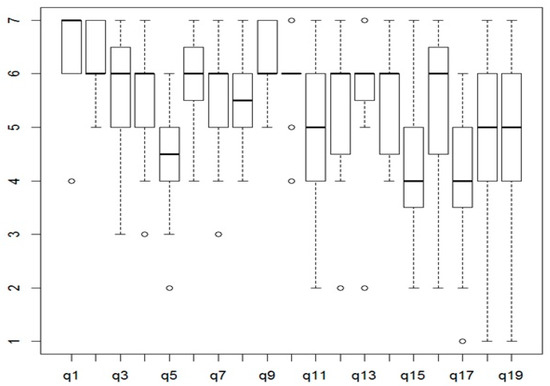
Figure 4.
Boxplot of second-round survey results.

Table 4.
Statistical analysis of the results of the second survey.
Through the analysis of the results of the Wilcoxon signed rank test, it was confirmed whether a consensus of the expert panel was reached for each item for the required capabilities for smart ammunition storage operation, the results of which are shown in Table 4. According to this analysis, an agreement was not reached for four out of the 19 items. An additional survey was conducted to derive the statistical consensus results for the four items (Nos. 5, 15, 17, and 18), suspended for the final decision.
4.3. Third Round of the Survey
In the third round of the survey, the central tendency and variability (median and interquartile range) were calculated for the responses of the expert panel collected during the second round of the survey, and the results were presented to each expert panel. The panels were then given time for reconsideration and modification for their responses to the second-round survey. For opinions that deviated from the majority responses, the reason for the discrepancy was described, and a statistical analysis of the group responses and the opportunity to modify one’s own response were provided. The statistical analysis results for the third-round survey items are shown in Table 5. As a result of the analysis, item 17 was excluded, and the remaining items, 5, 15, and 18, were included. It was additionally derived that the use of eco-friendly energy for operating the ammunition storage and the ability to supply emergency power for the operation of the Uninterruptible power supply (UPS) system are important factors in the capabilities required for the operation of smart ammunition storage.

Table 5.
Statistical analysis of results of third survey.
4.4. Derivation of Required Capabilities for Smart Ammunition Storage
As a result of analyzing the common points for the major capability factors derived through the survey, the capabilities can be classified into the following four areas.
First, capabilities are needed in the area of smart control, integrated protection, and safety. Detailed required capabilities include smart ground defense capability, air and drone defense capability, Electromagnetic pulse (EMP) and Chemical, Biological, Radiological (CBR) protection (detection/alarm/response) capability, cyber protection capability for information security, real-time access control capability for personnel and vehicles (parking and traffic), and real-time smart integrated control and control capability.
Second, detailed requirements for smart ammunition logistics and processing capabilities include the ability to share real-time ammunition information between ammunition units, a smart ammunition maintenance/inspection/safety management capability, an intelligent ammunition logistics management capability, and ammunition leakage testing and monitoring capabilities.
The third area includes capabilities in the areas of smart facility management and energy. The detailed capabilities required include ability in the management and control of the environment (e.g., temperature, leakage, condensation, and smoke) of the ammunition storage, the ability to operate smart barracks facilities, the ability to apply an operating platform for integrated control, emergency power supply capability for UPS systems operation (generator and UPS), and capabilities regarding renewable energy utilization (e.g., solar power) and zero energy unit control and management.
The final area of capabilities is the ability to link and operate a smart ICT infrastructure. Details of the required capabilities include the ability to control the infrastructure of the entire facility and achieve automatic management, achieving an interconnection with the current army Command, Control, Communications, Computer and Intelligence (C4I) system, and applying redundant internal and external wired and wireless communication based on reliability.
This technology-oriented smart military base is expected to optimize the utilization of energy, water, and usage of materials required for military activities and missions, and at the same time to improve the environment for underground ammunition storage, as well as the convenience of operators and working environments in underground and indoor environments [18,19]. This smart ammunition storage will serve as an exemplary model for sustainable military operation because it can reduce the number of energy resources required for military operation [20,21,22,23,24].
5. Analysis of the Element Technologies for Implementation of Smart Underground Ammunition Storage
Based on the required capabilities for smart ammunition storage, element technologies for implementation of the storage in practice were analyzed. Smart ammunition storage can be built through the convergence of a range of ICT technologies such as sensors, clouds, big data, precision control, and mobile technologies with the existing ammunition storage facilities and infrastructure. In addition, high-level automation and an intelligent infrastructure can be provided, enabling an improvement in the ammunition management capabilities, energy saving, and the establishment of a safe operating environment and a flexible management system. However, the four goals of safety, security, smart capabilities, and integration are required, as shown in Figure 5, in consideration of wartime ammunition support and the characteristics of the military. Based on these four technology selection goals (3SI), the correlation between the currently developed element technologies and the required capabilities for smart underground ammunition storage was mapped. As a result, as shown in Figure 6, a correlation diagram was derived.
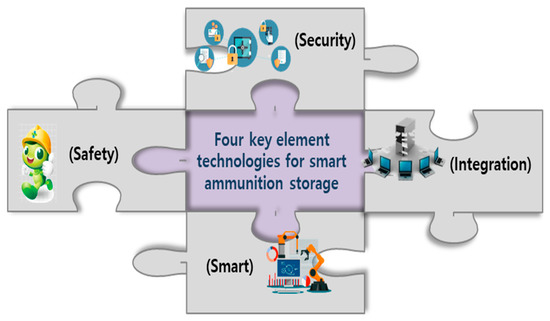
Figure 5.
Four key requirements for selecting technologies.
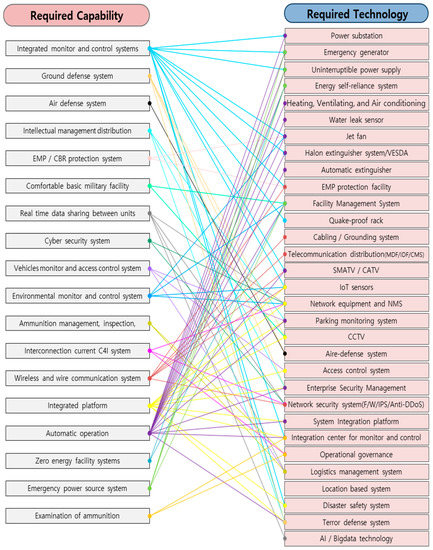
Figure 6.
Correlation diagram between required capabilities and selected technologies.
6. Discussion
A smart underground ammunition storage has the advantages of reducing the safe distance by confining blast waves and fragments generated in the event of an accidental explosion of ammunition in an underground rock mass, and improving the shortening of the storage life of ammunition due to climate change on the ground. This is a future outlook for ammunition storage, incorporating smart technologies of the fourth industrial revolution into the automation of ammunition reception/dispensing, inventory management, and energy saving. This will serve as a new cooperative project for civil-military coexistence by replacing military forces, which are being reduced in number owing to changes in the demographic structure of the country and from national defense reforms, with technology, as well as reducing the safe distance required to protect the property rights of local residents. In particular, the protected zone of domestic military facilities is approximately 9.110 billion km2, which is approximately 9.1% of the total area of the national land. Considering that a wider protected zone is required within the vicinity of the ammunition unit compared to other military facilities, a smart underground ammunition storage will be a model that should be actively adopted in South Korea, where the available land area is limited. In addition, by applying advanced science and technology, the storage life of the ammunition will be increased, and by constructing a sustainable ammunition storage, such as by the use of new and renewable energy, it will be possible to escape from the labor-intensive operation by soldiers required in the past. In addition, by releasing the protected zone of the ammunition unit located in the metropolitan hub, the effective use of national land and the private property rights of individuals can be guaranteed, and thus the military facility, which is no longer the target of avoidance, can be developed into a facility of cooperation with the local residents, which is the outlook of the smart military camp. Although 18 required capabilities and 32 element technologies were derived through this study, additional study is needed in order to optimize and operate these into a single platform.
7. Conclusions
In this study, a Delphi analysis was conducted for external experts to analyze the required capabilities and element technologies for the operation of a smart underground ammunition storage. The 24 external experts on smart technology were selected as the panel members. For the construction of smart underground ammunition storage, a total of 18 required capabilities and 32 element technologies were derived (Figure 6). Through the integration of these technologies, numerous sensors in the ammunition storage will collect data and compile them into big data, which will support human decision-making. In addition, smart ICT adopted in the smart ammunition storage will allow operators to detect changes in the surrounding environment, which will bring about innovation in the performance of ammunition reception/dispensing management. This future version of ammunition storage will serve as an example, tackling the major issues of ammunition management services and overcoming challenges such as a reduction of military forces, through advanced smart technology.
Author Contributions
Conceptualization, Y.-J.P. and K.K.; methodology, K.K. and H.A.; software, K.K.; validation, Y.-J.P., K.K., and H.A.; formal Analysis, K.K.; investigation, H.A.; resources, Y.-J.P.; data curation, K.K. and H.A.; writing—original draft preparation, K.K.; writing—review & editing, Y.-J.P.; visualization, H.A.; supervision, Y.-J.P.; project administration, H.A. and Y.-J.P.; funding acquisition, Y.-J.P. All authors have read and agreed to the published version of the manuscript.
Funding
This research was supported by a Grant (2019R1F1A106009812) from National Research Foundation of Korea and Anyang City.
Institutional Review Board Statement
Not applicable.
Informed Consent Statement
Not applicable.
Data Availability Statement
Data sharing not applicable.
Acknowledgments
This work was supported by the research fund of the National Research Foundation of Korea and Anyang City.
Conflicts of Interest
The authors declare no conflict of interest. The funders had no role in the design of this study, collection, analyses, or interpretation of the data, writing of the manuscript, or in the decision to publish the results.
References
- Department of Defense. Manual of DOD Ammunition and Explosives Safety Standards; Department of Defense Explosive Safety Board: Alexandria, VA, USA, 2017.
- Ministry of National Defense. Instruction of Safety Control Standard for Ammunition and Explosion; Ministry of National Defense: Seoul, Korea, 2019.
- North Atlantic Treaty Organization. Allied Ammunition Storage and Transport Publication (AASTP)-1: Nato Guidelines for the Storage of Military Ammunition and Explosives; NATO Standardization Office: Brussels, Belgium, 2015. [Google Scholar]
- BSRIA. The Smart Building Market in AsiaWill Exceed $1036 bn by 2020. Available online: https://www.bsria.co.uk/news/article/the-smart-building-market-in-asia-will-exceed-$1,036bn-by-2020/ (accessed on 10 November 2020).
- Kim, K.; Park, Y. Development of design considerations as a sustainability approach for military protective structures: A case study of artillery fighting position in South Korea. Sustainability 2020, 12, 6479. [Google Scholar] [CrossRef]
- Lim, C.; Min, K.; Kim, K.; Park, Y. Cost Effective and sustainable test methods to investigate vulnerabilities of EMP attack on existing building using public frequency devices. Sustainability 2021, 13, 570. [Google Scholar] [CrossRef]
- Nam, T.; Pardo, T.A. Smart city as urban innovation: Focusing on management, policy, and context. In Proceedings of the 5th International Conference on Theory and Practice of Electronic Governance, Tallinn, Estonia, 26–28 September 2011; pp. 185–194. [Google Scholar]
- Komninos, N. Intelligent Cities: Innovation, Knowledge Systems and Digital Spaces; Routledge: Abingdon, UK, 2013; pp. 1–320. [Google Scholar]
- Shapiro, J.M. Smart cities: Quality of life, productivity, and the growth effects of human capital. Rev. Econ. Stat. 2006, 88, 324–335. [Google Scholar] [CrossRef]
- Deakin, M. Smart Cities: Governing, Modelling and Analyzing the Transition; Routledge: Abingdon, UK, 2013; pp. 1–236. [Google Scholar]
- Pereira, Â.G.; Quintana, S.C. From technocratic to participatory decision support systems: Responding to the new governance initiatives. J. Geogr. Inf. Decis. Anal. 2002, 6, 95–107. [Google Scholar]
- Dalkey, N.C. The Delphi Method; An Experimental Study of Group Opinion; RM-5888-PR; The Rand Corp: Santa Monica, CA, USA, 1969. [Google Scholar]
- Thompson, B. Exploratory and Confirmatory Factor Analysis: Understanding Concepts and Applications; American Psychological Association: Washington, DC, USA, 2004. [Google Scholar]
- Cattell, R.B. The screen test for the number of factors. Multivar. Behav. Res. 2010, 1, 245–276. [Google Scholar] [CrossRef] [PubMed]
- Henry, F.K. The Varimax considerations for analytic rotation in factor analysis. Psychometrika 1958, 23, 187–200. [Google Scholar]
- Anderson, D. Strands of System: The Philosophy of Charles Peirce; Purdue University Press: West Lafayette, IN, USA, 1995. [Google Scholar]
- Ewing, D.M. Future Competencies Needed in the Preparation of Secretaries in the State of Illinois Using the Delphi Technique. Ph.D. Thesis, University of Illinois, Champaign, IL, USA, 1991. [Google Scholar]
- Buckman, A.H.; Mayfield, M.; Beck, S.B.M. What is a smart building? Smart Sustain. Built Environ. 2014, 3, 92–109. [Google Scholar] [CrossRef]
- Attoue, N.; Shahrour, I.; Younes, R. Smart building: Use of the artificial neural network approach for indoor temperature forecasting. Energies 2018, 11, 395. [Google Scholar] [CrossRef]
- To, W.M.; Lee, P.K.C.; Lam, K.H. Building professionals’ intention to use smart and sustainable building technologies—An empirical study. PLoS ONE 2018, 13, e0201625. [Google Scholar] [CrossRef] [PubMed]
- Siano, P.; Shahrour, I.; Vergura, S. Introducing smart cities: A transdisciplinary journal on the science and technology of smart cities. Smart Cities 2018, 1, 1–3. [Google Scholar] [CrossRef]
- Allam, Z.; Newman, P. Redefining the smart city: Culture, metabolism and governance. Smart Cities 2018, 1, 4–25. [Google Scholar] [CrossRef]
- Deakin, M.; Reid, A. Smart cities: Under-gridding the sustainability of city-districts as energy efficient-low carbon zones. J. Clean. Prod. 2018, 173, 39–48. [Google Scholar] [CrossRef]
- Saritas, O.; Burmaoglu, S. Future of sustainable military operations under emerging energy and security considerations. Technol. Forecast. Soc. Chang. 2016, 102, 331–343. [Google Scholar] [CrossRef]
Publisher’s Note: MDPI stays neutral with regard to jurisdictional claims in published maps and institutional affiliations. |
© 2021 by the authors. Licensee MDPI, Basel, Switzerland. This article is an open access article distributed under the terms and conditions of the Creative Commons Attribution (CC BY) license (http://creativecommons.org/licenses/by/4.0/).